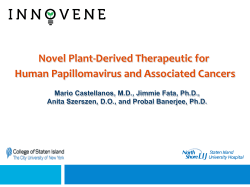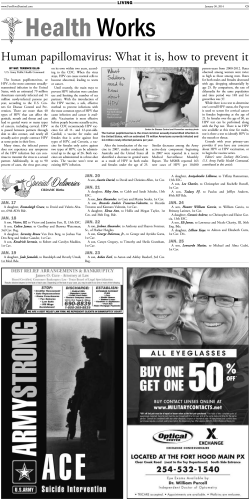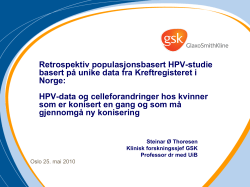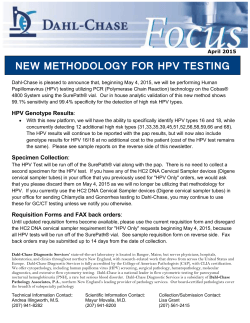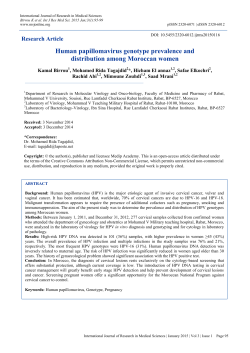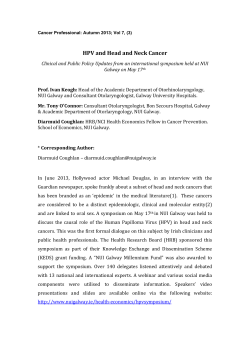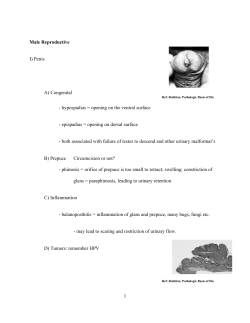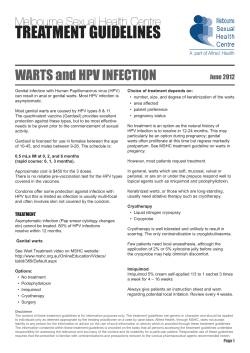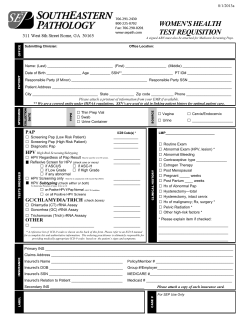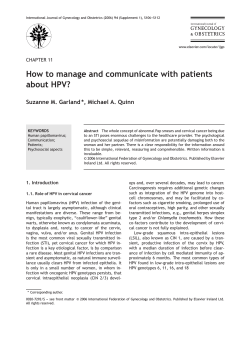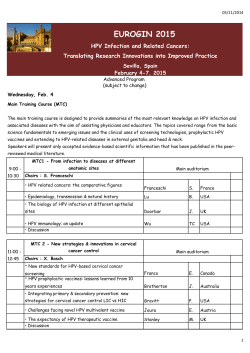
cancer, and low-risk types, such as 6 and
Transmission and transformation: Reviewing HPV’s lifecycle Betty M. Chung and Tyler C. Cymet, DO Although the currently accepted understanding of human papillomavirus (HPV) transmission is incomplete, reviewing the known information about the HPV lifecycle is a useful exercise to provide physicians with a foundation from which to question how HPV is transmitted and how it may be transformed into a carcinogenic infection. As HPV transmission comes to be better understood through greater physician awareness and further research, we can expect the development of more efficient and more patient population-inclusive vaccines. The human papillomaviruses belong to the Papillomaviridae family, which consists of more than 100 nonenveloped, icosahedral capsid, double-stranded circular DNA viruses. These viruses are associated with benign cutaneous and mucosal lesions (papillomas, verrucae, warts and condylomas); neoplasms and malignant tumors of the head and neck (oropharyngeal and esophageal), vulva, penis, perianal and anal regions, cervix; and nonmelanoma skin cancers. HPV is a ubiquitous virus, and productive infection with subsequent virion synthesis requires differentiation of the basal epithelial host cell.1 However, based on clinical data that takes note of recurrence of HPV lesions in immunosuppressed renal transplant patients and children with recurrent laryngeal papillomatosis infected with certain types of HPV, there may also exist a latent viral state. This viral state can be reactivated, in which HPV DNA may be detectable in the absence of active virion synthesis and assembly.1 At least 40 of these viruses are known to infect the genital tract and include those high-risk types, such as 16, 18, 31, 33 and 45, that have been associated with cervical 4 cancer, and low-risk types, such as 6 and 11, that have not been shown to be correlated with malignancies.2 HPV is thought to gain entry into the human body via microtrauma or abrasions to the skin or mucosa that expose the basal cells of the epithelium to HPV infection. HPV demonstrates tropism toward the keratinocytes in the basal layer of the stratified squamous epithelia of these structures.3 Although most recent literature has focused on the sexual mode of HPV transmission, researchers also have observed cases of nonsexual transmission, such as in virgin females, children and neonates.4, 5 The virus then uncoats and delivers its genome of eight genes to the host cell nucleus to be expressed as autonomous replicating episomal or extrachromosomal elements. Using host cell machinery, viral DNA is replicated and then segregated into progeny cells. Subsequently, one daughter cell remains in the basal layer to serve as a reservoir for the replication of more viral DNA while the other daughter cell migrates suprabasally, where HPV inhibits the cell from its normal exit from the cell cycle. Differentiation of infected cells is necessary for productive infection of the host cell and is coupled with expression of late viral capsid genes for completion of the viral lifecycle.10 HPV infection and lifecycle HPV infects squamous epithelial cells in the cervix, glans of the penis, penile shaft, scrotum and anal verge by interacting with putative host cell surface receptors such as heparan sulfate proteoglycans6 and alpha 6 integrins.7 The virus enters the cell via clathrin-mediated8 or caveolin-mediated endocytosis,9 depending on the HPV type. HPV genome and replication The HPV genome contains eight genes with multiple promoters and a number of splice variants that are expressed either early (E) or late (L) in the HPV lifecycle. The early genes encode nonstructural proteins that participate in DNA replication, transcriptional regulation, cell transforma- tion and viral assembly and release. The late (L) genes, L1 and L2, encode viral capsid proteins. An additional 1000bp noncoding region of the 8000bp HPV genome contains transcriptional regulatory sequences and the viral origin of replication.11 Papillomaviruses are thought to have two modes of replication: stable and vegetative. The stable replicative form exists as a circular episomal genome in the cells of the basal and parabasal layers of low-risk HPV infected squamous epithelial cells while the vegetative form occurs in highly differentiated cells at the epithelial surface. The hallmark of malignant transformation by high-risk HPV types is the integration of the viral genome into the host cell genome.12 The first viral genes to be expressed, E6 and E7, are involved in cell transformation in HPV high-risk types. E6 complexes with the cellular ubiquitin ligase. The E6AP and the E6AP/E6 complex acts as a p53 specific ubiquitin protein ligase to increase the rate of p53 degradation, thereby negating the anti-proliferative and pro-apoptotic functions of p53 in cases of DNA damage and cellular stress.13 E7, similar to E6, is also an oncoprotein. E7 complexes with hypophosphorylated pocket proteins pRb, p107 or p130, facilitating the release of the transcription factor E2F, which then constitutively activates DNA synthesis and cell proliferation.14 The Rb tumor suppressor protein normally binds to and inactivates E2F. E7 has also been shown to inactivate the cyclin dependent kinase (Cdk) inhibitors, p21/Cip1 and p27/Kip1 and complex with cyclins A and E.1, 15 However, in low-risk HPV types, such as HPV6 and HPV11, E6 may or may not bind to p53. In either case, it does not stimulate p53 degradation and E7 does not bind pRb with high affinity.16 In some HPV types, E6 has been shown to enhance telomerase activity, allowing for continuous cell proliferation.17 The other early genes are expressed as the cell differentiates. E1 and E2 are both DNA binding proteins. E1 is a DNA helicase/ATPase involved in viral genome replication while E2 is a transcription factor that binds to four sites within the viral noncoding region and recruits E1 to the viral origin of replication.18 E1 and E2 have been shown to be sufficient for transient replication of the HPV genome. In addition, increased levels of active E1 and E2 have been correlated with increased viral copy number.1,19 E2 also binds to the early promoter and decreases the expression of E6 and E7. There- concentrations of E2, displacement of basal transcription factors are thought to be responsible for the inactivation of the promoter and repression of E6 and E7 expression.7 Additionally, a switch in promoter usage to the differentiation-dependent late promoter, which is not repressible by E2, during differentiation is due to changes in fore, loss of E2 during integration of viral DNA into the host genome is the first stage in transformation.20 E2 exists in a full-length form that acts as a transcriptional activator of the early promoter at low levels of E2 expression and a truncated form at high levels of E2 expression that acts as a transcriptional repressor of the early promoter production of oncoproteins E6 and E7.7, 21, 22 At higher cellular signaling and not genome amplication. This switch results in increased levels of E1 and E2 and subsequent replication of the viral genome.1, 7 E4 gene sequences are not highly conserved among the various HPV types. Although E4 has been shown to associate with cytokeratins to destabilize the cytokeratin network and aid in viral release at the epithelial cell layer surface, its primary 5 function is still unknown.23 However, E4 has been shown to cause G2 cell cycle arrest and antagonize E7-mediated cell proliferation. Researchers also have hypothesized that E4 associates with E2.7 E5 proteins are hydrophobic transmembrane proteins that seem to be weakly involved in cellular transformation and modulate the activity of the epidermal growth factor (EGF) receptor tyrosine kinase signaling pathway.24 E5 is present on plasma, Golgi and ER membranes. Researchers also believe that E5 associates with the vacuolar ATPase and delays endosomal acidification in addition to inhibiting gap junctionmediated cell-cell communication in keratinocytes. This results in an increase in EGF receptor recycling to the cell membrane and an inability to respond to paracrine growth inhibitory signals.7, 25 E5 expression in high-risk HPV types is thought to occur early during carcinogen- enough––enough that viral particles are sloughed off at the skin surface to infect other cells and hosts. L2 expression pre- Most HPV infections are latent or asymptomatic in immunocompetent hosts but can become reactivated in cases of cell-mediated immunosuppression. cedes that of L1 and the presence of E2 is thought to increase the efficiency of this process.27 The lytic release of viral progeny requires terminal differentiation of stratified epithelium, a prerequisite for the activation of differentiation-dependent late viral promoters.28 Most HPV infections are latent or asymptomatic in immunocompetent hosts but can become reactivated in cases of cell-mediated immunosuppression. diated S phase entry and cell proliferation do result in the accumulation of multiple mutations in the host genome.7, 29 However, cases of rapid onset of carcinogenesis after initial infection also have been noted.30 The highest incidences of HPVrelated cancers are associated with cancer of the cervix in females and of the anus in homosexual men.31 Research has suggested that HPV can more easily access the basal epithelial cells at both of these sites due to the presence of reserve cells in the transformation zone that will eventually take on the basal cell phenotype.7 Integration of HPV DNA at specific sites in the host cell genome has been suggested to be an early and critical step in cancer progression.31 This also suggests the participation of certain flanking sequences in the integration of viral DNA as a step in carcinogenesis.32 Final notes While we can describe the groups of patients that are more likely than others to develop cancer from HPV infection, we still do not understand very well why homosexual men, women who have sex with uncircumcised males and women with multiple sexual partners are more likely to develop cancer. Although research has made great strides in putting together the pieces of the puzzle with respect to HPV—and we currently vaccinate women against the four most virulent types of HPV associated with cervical cancer—we still have more to discover before we can protect all individuals who are susceptible to the development of HPV-related cancers. ❙ ww References 1. Stubenrauch F, Laimins LA. Human papillomavirus esis because expression is inhibited by incorporation of the viral genome during progression to cervical cancer.26 The functions of E3 and E8 are still unknown. As infected host cells become terminally differentiated, the late genes, L1 and L2—which encode the major and minor structural capsid proteins—are expressed until the viral copy number increases 6 Molecular mechanisms of carcinogenesis by HPV Progression to cancer with many HPV types results after years of active infection. Although it has been shown that E6 and E7 expression is not sufficient to transform human keratinocytes in culture, E6 inactivation of the p53 response to DNA damage and cellular stress and repeated E7-me- life cycle: active and latent phases. Semin Cancer Biol. 1999;9:379-386. 2. de Villiers EM. Papillomavirus and HPV typing. Clin Dermatol. 1997;15:199-206. 3. Castle PE. Human papillomavirus (HPV) genotype 84 infection of the male genitalia: further evidence for HPV tissue tropism? J Infect Dis. 2008;197:776-778. 4. Rice PS, Cason J, Best JM, Banatvala JE. High risk 17. Stîppler H, Hartmann DP, Herman L, Schlegel R. 28. Molecular Biology of Human Papillomaviruses genital papillomavirus infections are spread vertically. The human papillomavirus type 16 E6 and E7 oncopro- page. Available at: http://www.ipvsoc.org/ Rev Med Virol. 1999;9:15-21. teins dissociate cellular telomerase activity from the MOLECULAR%20%20BIOLOGY%20%20OF%20%20H maintenance of telomere length. J Biol Chem. UMAN%20%20PAPILLOMAVIRUSES.htm. Accessed 1997;272:13332-13337. April 24, 2009. 18. Hughes FJ, Romanos MA. E1 protein of human pa- 29. Hawley-Nelson P, Vousden KH, Hubbert NL, Lowy pillomavirus is a DNA helicase/ATPase. Nucleic Acids DR, Schiller JT. HPV16 E6 and E7 proteins cooperate to 5. Syrjänen S, Puranen M. Human papillomavirus infections in children: the potential role of maternal transmission. Crit Rev Oral Biol Med. 2000;11:259-274. 6. Patterson NA, Smith, JL, Ozbun MA. Human papillo- Res. 1993;21:5817-5823. mavirus type 31b infection of human keratinocytes immortalize human foreskin keratinocytes. EMBO J. 1989;8:3905-3910. does not require heparan sulfate. J Virol. 19. Del Vecchio AM, Romanczuk H, Howley PM, Baker 2005;79:6838-6847. CC. Transient replication of human papillomavirus 30. Woodman CB, Collins S, Winter H, et al. Natural DNAs. J Virol. 1992;66:5949-5958. history of cervical human papillomavirus infection in 7. Doorbar J. Molecular biology of human young women: a longitudinal cohort study. Lancet. papillomavirus infection and cervical cancer. Clin Sci 20. Talora C, Sgroi DC, Crum CP, Dotto GP. Specific (Lond). 2006;110:525-541. down-modulation of Notch1 signaling in cervical can- 2001;357:1831-1836. cer cells is required for sustained HPV-E6/E7 expres- 31. Bosch FX, de Sanjosé S. Chapter 1: Human papillo- 8. Day PM, Lowy DR, Schiller JT. Papillomaviruses in- sion and late steps of malignant transformation. mavirus and cervical cancer—burden and assessment fect cells via a clathrin-dependent pathway. Virology. Genes Dev. 2002;16:2252-2263. of causality. J Natl Cancer Inst Monogr. 2003;31:3-13. 2003;307:1-11. 21. Ushikai M, Lace MJ, Yamakawa Y, et al. Trans ac- 32. Yu T, Ferber MJ, Cheung TH, Chung TK, Wong YF, 9. Bousarghin L, Touzé A, Sizaret PY, Coursaget P. tivation by the full-length E2 proteins of human papil- Smith DI. The role of viral integration in the develop- Human papillomavirus types 16, 31, and 58 use lomavirus type 16 and bovine papillomavirus type 1 in ment of cervical cancer. Cancer Genet Cytogenet. different endocytosis pathways to enter cells. J Virol. vitro and in vivo: cooperation with activation domains 2005;158:27-34. 2003;77:3846-3850. 10. Doorbar J. The papillomavirus life cycle. J Clin Virol. 2005;32:S7-S15. 11. Bernard HU. Gene expression of genital human papillomaviruses and considerations on potential antiviral approaches. Antivir Ther. 2002;7:219-237. 12. eMedicine from WebMD. Human papillomavirus page. Available at: http://emedicine.medscape.com/ article/219110-overview. Accessed April 24, 2009. 13. Scheffner M, Huibregtse JM, Vierstra RD, Howley PM. The HPV-16 E6 and E6-AP complex functions as a ubiquitin-protein ligase in the ubiquitination of p53. Cell. 1993;75:495-505. 14. Münger K, Howley PM. Human papillomavirus immortalization and transformation functions. Virus Res. 2002;89:213-228. 15. Duensing S, Münger K. Mechanisms of genomic instability in human cancer: insights from studies with human papillomavirus oncoproteins. Int J Cancer. 2004;109:157-162. 16. Parish JL, Kowalczyk A, Chen HT, et al. E2 proteins from high- and low-risk human papillomavirus types differ in their ability to bind p53 and induce apoptotic cell death. J Virol. 2006;80:4580-4590. of cellular transcription factors. J Virol. 1994;68:66556666. 22. Bernard BA, Bailly C, Lenoir MC, Darmon M, Thierry F, Yaniv M. The human papillomavirus type 18 (HPV18) E2 gene product is a repressor of the HPV18 regulatory region in human keratinocytes. J Virol. 1989;634317-4432. 23. Sterling JC, Skepper JN, Stanley MA. Immunoelectron microscopical localization of human papillomavirus type 16 L1 and E4 proteins in cervical keratinocytes cultured in vivo. J Invest Dermatol. 1993;100:154-158. 24. DiMaio D, Mattoon D. Mechanisms of cell transformation by papillomavirus E5 proteins. Oncogene. 2001;20:7866-7873. 25. Thomsen P, van Deurs B, Norrild B, Kayser L. The HPV16 E5 oncogene inhibits endocytic trafficking. Oncogene. 2000;19:6023-6032. 26. Oelze I, Kartenbeck J, Crusius K, Alonso A. Human papillomavirus type 16 E5 protein affects cell-cell communication in an epithelial cell line. J Virol. 1995;69:4489-4494. 27. Zhao KN, Hengst K, Liu WJ, et al. BPV1 E2 protein enhances packaging of full-length plasmid DNA in Betty M. Chung is a DO/PhD candidate at the University of Medicine and Dentistry of New Jersey-School of Osteopathic Medicine. Tyler C. Cymet, DO, is the associate vice president for medical education at the American Association of Colleges of Osteopathic Medicine. He is the president of the Maryland Association of Osteopathic Physicians and is on the Board of Trustees for DOCARE International. He can be reached at [email protected]. BPV1 pseudovirions. J Virol. 2000;272:382-393. 7
© Copyright 2026
